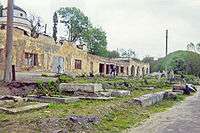Cemetery of the Defenders of Lwów

The Cemetery of the Defenders of Lwów (Polish: Cmentarz Obrońców Lwowa, Cmentarz Orląt, Cemetery of Eaglets, Orlat Cemetery) is a memorial and a burial place for the Poles and their allies who died in Lviv (Polish: Lwów) during the hostilities of the Polish-Ukrainian War and Polish-Soviet War between 1918 and 1920.
The complex is a part of the city's historic Lychakiv Cemetery. There are about 3000 graves in that part of the cemetery; some from the Lwów Eaglets young militia volunteers, after whom that part of the cemetery is named. It was one of the most famous necropolises of the interwar Poland.
It was neglected after World War II by the Ukrainian Soviet Socialist Republic, and at one time damaged with a bulldozer. Since the fall of communism, the cemetery has seen constant rebuilding and refurbishment and continues to be one of the principal tourist attractions of Lviv.
In the Second Polish Republic
In 1918–1919, Poles and Ukrainians fought over the territory of Eastern Galicia that included Lviv; with Poland defeating the Western Ukrainian People's Republic.[1] A year later, another war, between Poland and the Russian SFSR, was fought around the city.[1] In the aftermath, the city ended up being part of interwar Poland, and the Polish authorities decided to construct a memorial to the Poles and their allies who died in the 1918–1920 hostilities in that region.[1]

The necropolis complex was designed by Rudolf Indruch, an architecture student from the Lviv Polytechnic whose project won the competition.[1] The most visible element was a domed chapel which towers over the tombs underneath.[1] Exhumed remains of the 72 fighters were put in catacombs located between the chapel and the tombs.[1] In addition to Polish fighters, this part of the cemetery also has graves and monuments to American (pilots from the Kościuszko Squadron) and French volunteers who fought on the Polish side, two monuments were dedicated to those Polish foreign allies.[1] Underneath, an inscription "Mortui sunt ut liberi vivamus" ("They died so we could live free") was engraved on a semi-circular colonnade monument.[1] A triumphal arch was flanked by two stone lions.[1] The necropolis was never finished; its construction continued until the outbreak of the Second World War.[1] Out of almost 3,000 tombs, 300 were dedicated to the Eaglets, as the young Polish defenders of the city from 1918 are known.[1] In 1925 the ashes of one of the unknown defenders of Lwów were transferred to the Tomb of the Unknown Soldier in Warsaw.[2]
Wartime devastation and aftermath
After the Soviet invasion of Poland and the events of World War II, the city became part of Soviet Ukraine, and the Polish historical monuments located at the cemetery were devastated or neglected.[1] The stone lions, the columnade, the monuments to foreign troops were removed.[1] Up to 1971 many of the sculptures were destroyed; the cemetery of Lviv Eaglets was completely destroyed and turned into a truck depot. Soviets attempted to destroy the triumphal arch with tanks.[1] In the 1970s, the majority of the tombs were razed with bulldozers.[1]

The Lviv Eaglets section was, however, not reopened for several decades, as the fact that many of the people buried there fought on the Polish side against the Ukrainians during the Polish-Ukrainian War generated some controversy.[1][3] The issue has resurfaced several times in the Polish-Ukrainian relations; however, in 1989 the reconstruction works have begun, carried by local Polonia and Polish workers working temporarily in Lviv.[1] Eventually the Cemetery of the Defenders of Lviv was reopened on 24 June 2005 when the Lviv City Council, which initially resisted the opening,[1][3] eventually changed its mind, following Polish support for Ukraine's Orange Revolution (2004).[1][4] President of Poland Aleksander Kwaśniewski and President of Ukraine Viktor Yushchenko, who attended the opening ceremony, agreed that the reconstruction and official opening represents a major improvement in Polish-Ukrainian relations.[1]
See also
References
- 1 2 3 4 5 6 7 8 9 10 11 12 13 14 15 16 17 18 19 20 Symbolic Reconciliation, 20 July 2005, Warsaw Voice. Last accessed on 22 March 2006.
- ↑ Jerzy Janicki (1990). Ni ma, jak Lwów--: krótki przewodnik po Lwowie. Oficyna Literatów "Rój". p. 130. Retrieved 4 May 2012.
- 1 2 UKRAINIAN, POLISH PRESIDENTS OPEN CONTROVERSIAL CEMETERY... Radio Free Europe/Radio Liberty Newsline, 05-06-27 Last accessed on 22 March 2006.
- ↑ Ukrainian authority agreed with Poland to open Eaglets Polish military cemetery in Lviv Archived September 28, 2007, at the Wayback Machine., National Radio Company of Ukraine announcement. 14-06-2005. Last accessed on 22 March 2006.
External links
| Wikimedia Commons has media related to Cemetery of the Defenders of Lwów. |
- THE REDEDICATION OF POLISH "CAMPO SANTO" IN Lwów (Lviv) BY PRESIDENTS OF UKRAINE AND POLAND
- In Defense of Lwow and the Eastern Borderlands
- Transitions Online Poland & Ukraine: Where Eaglets Lie
- The Orlat Cemetery
- President of The Republic of Poland – News on opening the cemetery
- Presidents of Ukraine and Poland unveil memorials at Lviv cemetery The Ukrainian Weekly, July 3, 2005, No. 27, Vol. LXXIII
- (Polish) 1939 Polish guidebook to the cemetery
Coordinates: 49°49′48″N 24°3′29″E / 49.83000°N 24.05806°E
